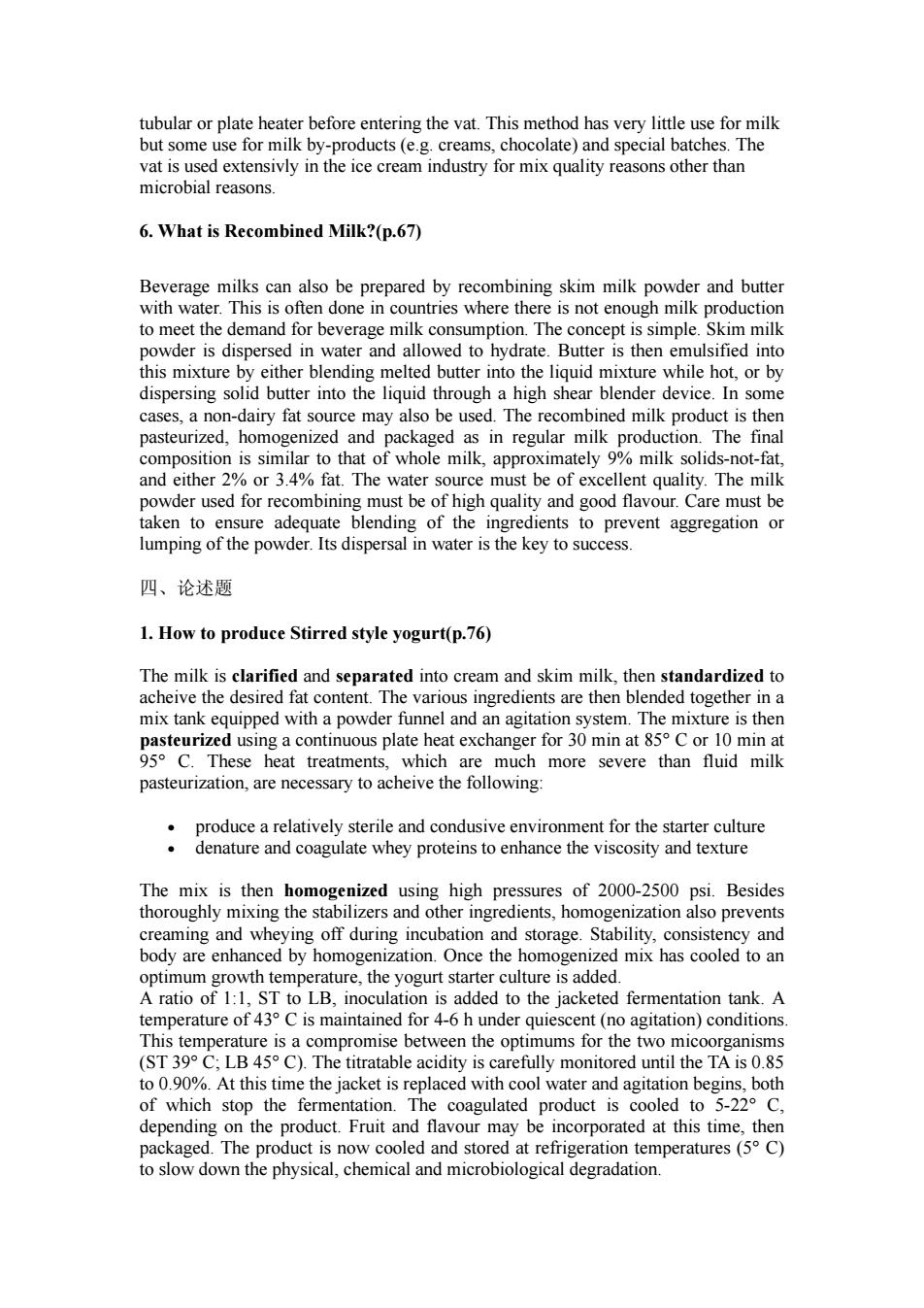正在加载图片...

tubular or plate heater before entering the vat.This method has very little use for milk but some use for milk by-products(e.g.creams,chocolate)and special batches.The vat is used extensivly in the ice cream industry for mix quality reasons other than microbial reasons. 6.What is Recombined Milk?(p.67) Beverage milks can also be prepared by recombining skim milk pow er and butte done in countries where th Is not eno ugh mil b ncept te t per outter into th the liqu 0 id thr In n-dairy fat s also be used.The mbined mill duct is the d ho ized and as in r mlar milk r oduction.The final composition is similar to that of whole milk,app oximately 9%milk solids. ot-fat and either 2%or 34%fat.The water source must be of excellent quality.The milk powder used for recombining must be of high quality and good flavour.Care must be taken to ensure adequate blending of the ingredients to prevent aggregation or lumping of the powder.Its dispersal in water is the key to success. 四、论述题 1.How to produce Stirred style yogurt(p.76) The milk is clarified and separated into cream and skim milk,then standardized to acheive the des with a powder funneens are then blende nded together in a mix tank innel and n agitat system mixture is the for Thes much pasteurizatior are necessary to acheive the ollowing more severe a relatively sterile ondusiv vir 4 nd c late whe y proteins to The mix is then homogenized using high pressures of 2000-2500 psi.Besides thoroughly mixing the stabilizers and other ingredients homogenization also prevents creaming and wheying off during incubation and storage.Stability,consistency and body are enhanced by homogenization.Once the homogenized mix has cooled to an optimum growth temperature,the yogurt starter culture is added A ratio of 1:1,ST to LB,inoculation is added to the jacketed fermentation tank.A temperature of 43 C is maintained for 4-6 h under quiescent(no agitation)conditions two micoorganism LB C).I the jac atable a arefully monit nt the s vith e ed The lod and s pe atures (5 to slow down ohysical chemical and microbiolo tubular or plate heater before entering the vat. This method has very little use for milk but some use for milk by-products (e.g. creams, chocolate) and special batches. The vat is used extensivly in the ice cream industry for mix quality reasons other than microbial reasons. 6. What is Recombined Milk?(p.67) Beverage milks can also be prepared by recombining skim milk powder and butter with water. This is often done in countries where there is not enough milk production to meet the demand for beverage milk consumption. The concept is simple. Skim milk powder is dispersed in water and allowed to hydrate. Butter is then emulsified into this mixture by either blending melted butter into the liquid mixture while hot, or by dispersing solid butter into the liquid through a high shear blender device. In some cases, a non-dairy fat source may also be used. The recombined milk product is then pasteurized, homogenized and packaged as in regular milk production. The final composition is similar to that of whole milk, approximately 9% milk solids-not-fat, and either 2% or 3.4% fat. The water source must be of excellent quality. The milk powder used for recombining must be of high quality and good flavour. Care must be taken to ensure adequate blending of the ingredients to prevent aggregation or lumping of the powder. Its dispersal in water is the key to success. 四、论述题 1. How to produce Stirred style yogurt(p.76) The milk is clarified and separated into cream and skim milk, then standardized to acheive the desired fat content. The various ingredients are then blended together in a mix tank equipped with a powder funnel and an agitation system. The mixture is then pasteurized using a continuous plate heat exchanger for 30 min at 85° C or 10 min at 95° C. These heat treatments, which are much more severe than fluid milk pasteurization, are necessary to acheive the following: • produce a relatively sterile and condusive environment for the starter culture • denature and coagulate whey proteins to enhance the viscosity and texture The mix is then homogenized using high pressures of 2000-2500 psi. Besides thoroughly mixing the stabilizers and other ingredients, homogenization also prevents creaming and wheying off during incubation and storage. Stability, consistency and body are enhanced by homogenization. Once the homogenized mix has cooled to an optimum growth temperature, the yogurt starter culture is added. A ratio of 1:1, ST to LB, inoculation is added to the jacketed fermentation tank. A temperature of 43° C is maintained for 4-6 h under quiescent (no agitation) conditions. This temperature is a compromise between the optimums for the two micoorganisms (ST 39° C; LB 45° C). The titratable acidity is carefully monitored until the TA is 0.85 to 0.90%. At this time the jacket is replaced with cool water and agitation begins, both of which stop the fermentation. The coagulated product is cooled to 5-22° C, depending on the product. Fruit and flavour may be incorporated at this time, then packaged. The product is now cooled and stored at refrigeration temperatures (5° C) to slow down the physical, chemical and microbiological degradation